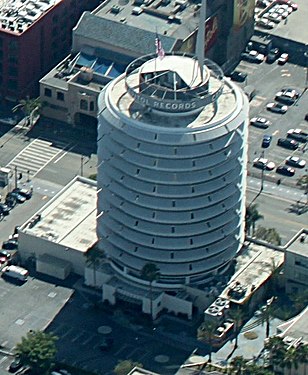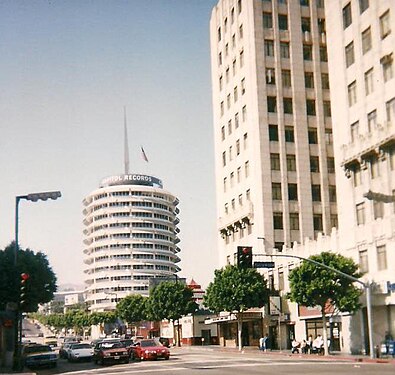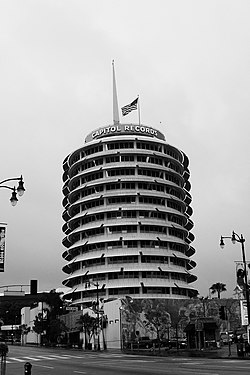
The Hollywood Bowl is an amphitheatre in the Hollywood Hills neighborhood of Los Angeles, California. It was named one of the 10 best live music venues in the United States by Rolling Stone magazine in 2018.
California's Gold is a public television human interest program that explores the natural, cultural, and historical features of California. The series ran for 24 seasons beginning in 1991, and was produced and hosted by Huell Howser in collaboration with KCET, Los Angeles. The series ceased production when Howser retired in November 2012, shortly before his death on January 7, 2013, although episodes continue to be shown on KCET and are featured on the page at the station's website about his shows.

Frederick Charles Slack was an American swing and boogie-woogie pianist and bandleader.
KCET is a secondary PBS member television station in Los Angeles, California, United States. It is owned by the Public Media Group of Southern California alongside the market's primary PBS member, Huntington Beach–licensed KOCE-TV. The two stations share studios at The Pointe in Burbank; KCET's transmitter is located atop Mount Wilson in the San Gabriel Mountains.

Huell Burnley Howser was an American television personality, actor, producer, writer, singer, and voice artist, best known for hosting, producing, and writing California's Gold and his human interest show Visiting... with Huell Howser, produced by KCET in Los Angeles for California PBS stations. The archive of his video chronicles offers an enhanced understanding of the history, culture, and people of California. He also voiced the Backson in Winnie the Pooh (2011).

The Dorothy Chandler Pavilion is one of the halls in the Los Angeles Music Center, which is one of the largest performing arts centers in the United States. The Music Center's other halls include the Mark Taper Forum, Ahmanson Theatre, and Walt Disney Concert Hall.

The Millennium Biltmore Hotel, originally the Los Angeles Biltmore, is a historic hotel opened in 1923 and located opposite Pershing Square in Downtown Los Angeles, California.

El Capitan Theatre is a fully restored movie palace at 6838 Hollywood Boulevard in the Hollywood neighborhood in Los Angeles, California, United States. The theater and adjacent Hollywood Masonic Temple is owned by The Walt Disney Company and serves as the venue for a majority of the Walt Disney Studios' film premieres.
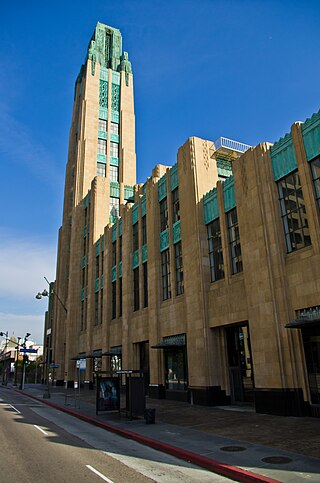
Bullocks Wilshire, located at 3050 Wilshire Boulevard in Los Angeles, California, is a 230,000-square-foot (21,000 m2) Art Deco building. The building opened in September 1929 as a luxury department store for owner John G. Bullock. Bullocks Wilshire was also the name of the department store chain of which the Los Angeles store was the flagship; it had seven stores total; Macy's incorporated them into and rebranded them as I. Magnin in 1989, before closing I. Magnin entirely in 1994. The building is currently owned by Southwestern Law School.

Millard Owen Sheets was an American artist, teacher, and architectural designer. He was one of the earliest of the California Scene Painting artists and helped define the art movement. Many of his large-scale building-mounted mosaics from the mid-20th century are still extant in Southern California. His paintings are in the Metropolitan Museum of Art and the Whitney Museum in New York, the Chicago Art Institute, the National Gallery in Washington D.C.; and the Los Angeles County Museum.
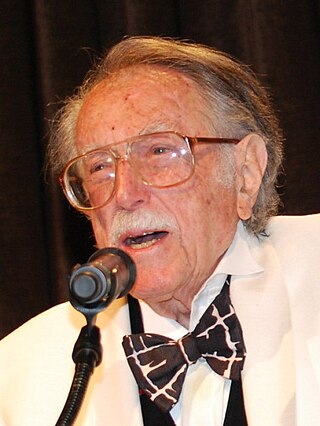
Julius Shulman was an American architectural photographer best known for his photograph "Case Study House #22, Los Angeles, 1960. Pierre Koenig, Architect." The house is also known as the Stahl House. Shulman's photography spread the aesthetic of California's Mid-century modern architecture around the world. Through his many books, exhibits and personal appearances his work ushered in a new appreciation for the movement beginning in the 1990s.
Outpost Estates is a neighborhood in the Hollywood Hills of Los Angeles, California, consisting of about 450 homes. It is bordered by Mulholland Drive to the north, Franklin Avenue to the south, Runyon Canyon Park to the west, and Hollywood Heights and the Hollywood Bowl to the east.

Capitol Studios is a recording studio located at the landmark Capitol Records Tower in Hollywood, California. The studios, which opened in 1956, were initially the primary recording studios for the American record label Capitol Records. While they are still regularly used by Capitol recording artists, the facilities began to be made available to artists outside the label during the late 1960s to the early 1970s. The studios are owned by Universal Music Group, the parent company of Capitol Music Group.

Wilshire Boulevard Temple, known from 1862 to 1933 as Congregation B'nai B'rith, is the oldest Jewish congregation in Los Angeles, California. Wilshire Boulevard Temple's main building, with a sanctuary topped by a large Byzantine revival dome and decorated with interior murals, is a City of Los Angeles Historic Cultural Monument and is listed on the National Register of Historic Places. The Moorish-style building, located on Wilshire Boulevard in the Wilshire Center district, was completed in 1929 and was designed by architect Abram M. Edelman.

The Old Warner Brothers Studio, now known as the Sunset Bronson Studios, is a motion picture, radio and television production facility located on Sunset Boulevard in Hollywood, Los Angeles, California. The studio was the site where the first talking feature film, The Jazz Singer, was filmed in 1927.
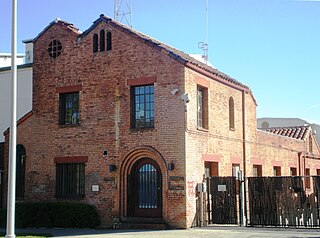
The KCET Studios, located at 4401 Sunset Boulevard in Hollywood, California is the longest continuously-producing studio in Hollywood. Since its establishment in 1912, the studios located at the site have been the home of motion picture producers, including Lubin, Essanay, Willis and Inglis, J.D. Hampton, Charles Ray, Ralph Like, Monogram Pictures, Allied Artists, and ColorVision. Since 1970, it has been the home of public television station KCET, but in April 2011, KCET announced that it had sold the facility to the Church of Scientology.
Wallichs Music City was a record store in Hollywood, California, US, founded by Glenn E. Wallichs, that also had stores in West Covina, Lakewood, Canoga Park, Costa Mesa, Torrance, Buena Park, and Hawthorne from 1940 to 1978 and was one of the first to display cellophane-sealed albums in racks. Wallichs stayed open until 2 a.m.
Tristan Eaton is an American artist. Primarily known for his toy designs and street art murals, Eaton is also a graphic designer and illustrator. In total, Eaton has painted about 100 murals around the world.

Richard J. Riordan Central Library, also known as the Los Angeles Central Library, is the main branch of the Los Angeles Public Library (LAPL), in Downtown Los Angeles. It is named after Mayor of Los Angeles Richard Riordan.


